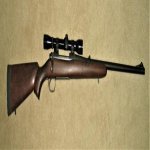Okay..... Any ideas?
Congratulations on your first try, kjohn. Before you do anything, try the rifle out and see how well it tames the recoil. Please let us know how you find that.
If you want to replace the pad, just remove it, sand the butt to remove all the old Shoe Goo, and install a new one. Doesn't take long.
Originally I was using epoxy cements, but all I use any more is water-based contact cement because it works so well, and the only waiting is for the cement to dry. Have not had a single one come loose... so far.
Also, rather than trying to get a close fit, I rough out the pad at least 1/4 inch bigger than the butt all the way around. That's what I glue to the stock, then sand to fit. That gives you something to hold and move the pad around a bit with.
The best thing about using water-based contact cement is no noxious fumes, so can be used indoors at any time. Just be sure both the stock and the pad are both absolutely dry before pressing them together. Wait until the shine is gone from the cement, then touch it with a piece of dry paper. If the paper comes away without sticking at all, it is ready to bond.
Getting it on straight? Next best thing is, you can also keep a piece of paper between the pad and the stock while you align the pattern on the flip flop until it is exactly the way you want it, then slide the paper out as you press the pad on to bond to the stock. No parachute cord like I first used. No weights, no bungees, etc, the bond is instant. You just have to press it on hard after it first bonds, and it is ready to be sanded.
Best,
Ted















































 RJ
RJ



























